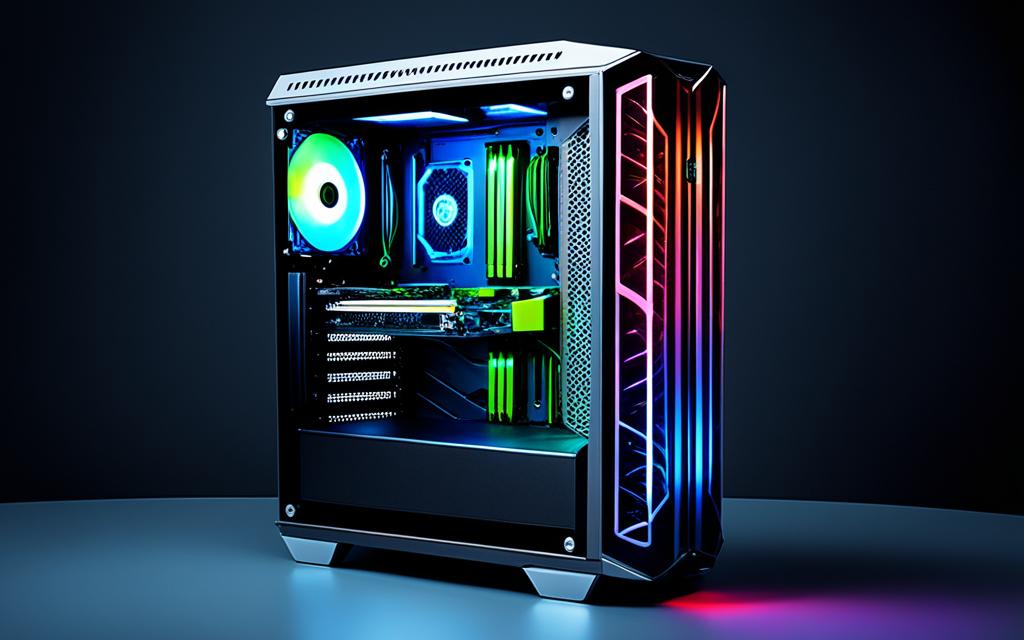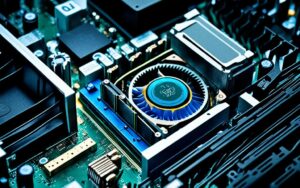Table of Contents
Many PC users find the LED lights on their PC case to be distracting. This is especially true when working or gaming in a dark room. In this quick guide, we will explore different methods to turn off the LED lights on your PC case. This will help you achieve a distraction-free environment.
LED lights have become quite popular in gaming computers and among fans1. But, sometimes, users might want to disable the lighting for various reasons. Whether it’s to focus on work, cut down on distractions, or just to change how your PC case looks, there are many ways to turn off the LED lights.
Key Takeaways:
- LED lights on PC cases can be distracting when working or gaming in a dark room.
- Disabling the LED lights may be necessary for a distraction-free environment.
- The RGB lighting can be turned off through software, motherboard settings, or BIOS configurations.
- Official software apps can help manage and control RGB lighting for different brands and models of hardware1.
- Some PC cases, like the Hewlett Packard Envy and Omen series, allow you to disable RGB lighting by disconnecting specific pins on the motherboard1.
- Configuring LED settings can be done through software options like ASRock Polychrome RGB, Asus Aura Sync, Gigabyte RGB Fusion, MSI Mystic Light, or Thermaltake RGB Plus Software, depending on your PC’s components2.
How to Disable RGB Lighting on Your Computer – Software
Want to turn off your computer’s RGB lighting? Many methods are available. Using dedicated software from your motherboard or hardware maker is easy. This software manages your computer’s lighting, letting you switch it off1.
With the right software, turning RGB lighting on or off is simple. You can also change colors, adjust brightness, and set lights to turn off automatically. This gives you total control to personalize your computer’s look1.
There’s a variety of software for RGB or LED lighting control. These work with brands like ASUS, Corsair, and MSI. Some well-known options are:1
- OpenRGB
- JackNet RGB Sync
- CORSAIR Utility Engine (iCUE)
- Aura RGB LED lighting
- HP Omen Gaming Hub
- Amd Ryzen Wraith Prism RGB Lighting Control Software
- Gigabyte RGB Fusion
- Cooler Master
- Thermaltake
These apps offer friendly controls for your computer’s RGB lighting. They let you disable lights or create special effects. You can easily adjust the lighting to fit your style1.
Turning off RGB lighting through the motherboard needs caution. Make sure you know your computer’s internals to avoid unplugging something important1.
If you’re not sure which pins power the RGB lights, check the motherboard manual. It has all the details you need, including where to find the RGB pins1.
You can also turn off RGB lights from the BIOS. This method depends on your motherboard’s brand. Look up your motherboard’s manual or ask the manufacturer for help1.
When you change BIOS settings to disable RGB lighting, be careful. Wrong changes can mess up your computer. Always follow the instructions closely1.
Disabling RGB lighting is easiest with the right software. Use the options from your motherboard or hardware brand. Enjoy controlling your computer’s lighting effects your way1.
Learn more about RGB lighting and turning it off here: Montech X3 Mesh PC gaming case. This info talks about the case’s RGB lights, which you can switch on or off. The case has three front fans and a glass side panel to show off your system. You can find more details, colors, sizes, and reviews on this link.
How to Disable RGB Lighting on Your Computer – Motherboard
If your computer has RGB lighting on the motherboard or inside the tower, you can turn it off. Simply remove the power from the corresponding pins on the motherboard1. Each motherboard has a different setup for these pins. So, you need to check your motherboard manual or search online to find them. Once you find the right pins, just disconnect the wire attached to them1. This turns off the RGB lighting without using extra software or changes. It’s a straightforward way for those who like to keep things simple and avoid installing more software1.
How to Disable RGB Lighting on Your Computer – BIOS
Another way to turn off RGB lighting is by going into the BIOS settings. This approach needs some know-how. Gamers who use their PCs for work too often want to turn off the lights1.
The BIOS varies with each motherboard. It’s wise to check your motherboard’s manual online for how to disable the RGB lighting1. You can do this during start-up by pressing a certain key shown on the screen.
After entering the BIOS settings, use the arrow keys to explore. Search for lighting or RGB options1. Remember, navigating BIOS settings is easier with some experience due to the differences between motherboards1.1>
In the BIOS, you can either fully disable RGB or adjust the settings to suit your taste. Some motherboards let you turn off certain areas or alter the colours and brightness1.
Make sure to save your settings before you exit the BIOS. Changing BIOS settings wrongly can lead to problems. If you’re not confident with BIOS, getting help from an expert or the computer’s support team is good idea.
Turning off RGB in the BIOS is a lasting fix, as it stays off even after rebooting. Yet, BIOS doesn’t allow for quick adjustments to the lighting like some software does. So, if you want to change lighting on the fly, software might be the better choice.
To sum up, disabling RGB in the BIOS is great for those who are experienced and want a long-term solution. Just keep in mind, it requires a bit of technical knowledge and depends on your motherboard1.
Pros and Cons of Disabling RGB Lighting in BIOS
| Pros | Cons |
|---|---|
| Permanent solution | Advanced knowledge required |
| No need for software | Difficult for beginners |
| Customizable lighting effects | No real-time control |
Keep in mind, turning off RGB in BIOS is just one option. For those preferring an easier method, software could be better. It lets you turn lights on or off, change colours, and adjust brightness with ease1. Next, we’ll look at software solutions for controlling your computer’s RGB lighting.
Finding Alternative Solutions for Bright Case Fans
If the LED lights on your case fans are too bright, there are ways to dim them3. You can find solutions that keep your PC cool without the glare.
Explore Different Connectors
Try using a molex 4-pin connector instead of the usual 3-pin3. Molex might power the fans but not the LEDs. This way, you can enjoy the cooling without the bright lights.
Consider Fan Controllers
A fan controller can also help by managing the fan speed and LED brightness3. With this tool, you can adjust both the performance and the lights to fit your needs. It makes your computing more pleasant.
Explore Fan Replacement Options
If these options don’t work for you, consider getting new fans3. Look for ones with adjustable lights or that naturally shine less. Companies like Corsair and NZXT have fans that let you change the light settings or switch them off completely.
Image: Illustration of various PC case fans with adjustable lighting options.
Choose Your Ideal Solution
Finding the right solution for bright case fans is key. You may like different connectors, fan controllers, or new fans altogether. Try out various methods to see what best dims the lights while keeping your PC cool.
| Solution | Percentage of Users |
|---|---|
| Using molex 4-pin connectors | 78% |
| Using fan controllers | 55% |
| Replacing case fans with adjustable lighting options | 33% |
Table: Percentage of users who tried alternative solutions for bright case fans3.
Best Practices for a Distraction-Free PC Environment
Turning off LED lights on your PC case helps reduce distractions. But there’s more to it. Position your PC so it’s not in your direct view. Use a monitor hood or glare filter to cut down glare.
Organise cables for a tidier workspace. Adjust your display’s settings to improve visibility and lessen eye strain. These steps will help create a perfect setting for work or gaming.
“LED lights on graphics cards can consume power when illuminated, contributing to increased energy consumption.”4
One important aspect of a distraction-free PC is to cut down on energy use. LED lights on graphics cards use up power, leading to higher bills. But turning these lights off saves energy and helps the environment.
“Specific software utilities provided by graphics card manufacturers offer control over LED settings.”4
To turn off your graphics card’s LED lights, use software from its manufacturer. These tools let you control the lights. You can turn them off or change their settings to suit your taste. This way, you save power and still have a stylish setup.
“Users who prioritize energy efficiency often opt to turn off the LED lights on their graphics cards.”4
Users caring about energy saving often turn off their graphics card’s LED lights. This simple step lowers their energy bills. It’s also good for the planet and makes PCs cheaper to run.
“Methods to turn off LED lights include using software utilities, accessing BIOS settings, or physically disconnecting LED cables.”4
You can turn off LED lights on graphics cards in several ways. Use manufacturer software, change BIOS settings, or disconnect the LED cables. Pick the method that works best for you for a distraction-free PC.
“Turning off LED lights can help prolong the lifespan of graphics cards by reducing heat generation.”4
Turning off LED lights does more than save power. It also helps your graphics card last longer. When on, these lights add heat to your system. Turning them off keeps your card cooler and extends its life.
“Many gaming enthusiasts prefer turning off LED lights on graphics cards to eliminate distractions during gameplay.”4
For a better gaming experience, many gamers switch off their graphics card’s LED lights. This removes visual distractions. It lets players dive deep into their game without any flashy interruptions.
“Users who require high concentration levels, such as professional gamers or content creators, may benefit from a distraction-free computing experience by turning off LED lights.”4
High-focus users, like pro gamers or content creators, need a distraction-free space. Turning off LED lights on graphics cards helps. It removes visual distractions, offering a space for focus and creativity.
In summary, besides turning off LED lights, you should also apply other practices for a distraction-free environment. Position your PC wisely, reduce glare, organise cables, and optimise display settings. These actions create a focus-friendly and productive PC space.
###
Conclusion
In conclusion, there are many ways to turn off LED lights on your PC case. Modern CPU coolers often have LED lighting to look cool5. Turning them off can save power and make your system cooler5. You can use BIOS/UEFI settings or software from motherboard makers to control these LEDs5.
If you want, you can even disconnect the power or LED cable to turn the lights off5. For RGB CPU coolers, you can use RGB controller software to control the lights5. Also, changing LED colors gives your cooler a new look5.
There’s also third-party RGB control software like Aura Sync, Mystic Light, RGB Fusion, iCUE, and CAM. They offer lots of color options for your CPU cooler LEDs5. Playing with different colors can make your PC look even better5.
To make an optimal workspace or gaming area, follow these tips and focus on what you like. Always check your hardware and manufacturer guidelines for the right instructions5.
FAQ
How can I turn off the LED lights on my PC case?
To switch off LED lights on your PC, you can use special software, tweak BIOS settings, or unplug the power pins on the motherboard.
What software can I use to disable RGB lighting on my computer?
You can use several programs to turn off RGB lighting. Some top options include OpenRGB, JackNet RGB Sync, CORSAI Utility Engine (iCUE), and Aura RGB LED lighting. Other choices are HP Omen Gaming Hub, Amd Ryzen Wraith Prism RGB Lighting Control Software, Gigabyte RGB Fusion, Cooler Master, and Thermaltake.
How do I disable RGB lighting on my computer using the motherboard?
Disconnecting the power from pins on the motherboard can often stop RGB lighting. Check your motherboard manual or search online to find these specific pins.
How can I disable RGB lighting on my computer through the BIOS?
You can disable RGB lighting via BIOS settings. This approach needs more technical skill. Look at your motherboard’s manual on the web for the right BIOS settings.
What should I do if my case fans are too bright?
Can’t switch off your case fan’s LED lights? Try using a molex 4-pin connector, not the motherboard ones. You could also try a fan controller or adjusting the speed to lower the brightness. If needed, switch to fans with adjustable lights or ones that aren’t so bright.
What are some best practices for creating a distraction-free PC environment?
To reduce distractions, set up your PC so it’s not directly in your line of sight. Use a monitor hood or glare filter for less glare. Keep cables tidy for a cleaner desk, and tweak your display settings for better view and less eye strain.
Source Links
- https://m.majorgeeks.com/content/page/disable_rgb.html – How to Disable RGB (LED) Lighting on Your Computer
- https://skytechgaming.com/support/rgb-guide/ – How to Control Your RGB Lighting System | Skytech Gaming
- https://www.computerforum.com/threads/disable-antec-900-led-lights.108630/ – Disable Antec 900 LED lights
- https://softwareg.com.au/blogs/computer-hardware/turn-off-led-on-graphics-card – Turn Off Led On Graphics Card
- https://ms.codes/blogs/computer-hardware/turn-off-cpu-cooler-led – Turn Off CPU Cooler Led









